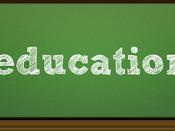Throughout the years, the general attitudes concerning the placement of special education students have changed over the years. The recent trend toward independent living for special education students is a step in the right direction, but special education programs have a way to go.
Both Public Law 94-142, Part B of the Individuals with Disabilities Education Act (IDEA), and Section 504 of the Rehabilitation Act of 1973 require that all school systems that receive federal funding must comply with Section 504 by making "free and appropriate public education" available to eligible and qualified students with disabilities. Special education and related services must be made available to any child with a qualifying disability when the disability impairs the children educational performance.
Part B of the IDEA not only requires that public schools provide a free education to children with disabilities, the law also sets parameters for determining an appropriate education.
Such education must include special education and related services specifically designed to meet each child's unique needs through an individualized education plan (IEP). An IEP is a plan developed for each child receiving special education services. A "multi-disciplinary team" (including parents, teachers and others) prepares the IEP. An IEP must include an evaluation of the child's academic performance and learning characteristics, social and emotional performance, health and physical development, annual goals, short term objectives to meet those goals, school environment and service recommendations, a detailing of the extent to which the student will participate in other school activities, any related service recommendations and a detailing of the extent to which the student will participate in state and citywide assessments, either with or without modifications. IEPs can be reviewed at any time upon request from any of the interested parties, and must be reviewed at least once a year.
Part B of the IDEA further requires public schools to meet a disabled child's needs to the maximum extent appropriate in a regular classroom with non-disabled peers. Under the IDEA all children who require special education services must be educated in the least restrictive setting appropriate to their individual needs. The statute states that "each public agency shall ensure - (1) That to the maximum extent appropriate children with disabilities ... are educated with children who are non-disabled; and (2) That special classes, separate schooling or other removal of children with disabilities from the regular educational environment occurs only if the nature or severity of the disability is such that education in regular classes with the use of supplementary aids and services cannot be achieved satisfactorily." In other words, if a child can learn in a general education class with necessary supports and services, she and/or he must be allowed to do so. If that's impossible, then there must be a continuum of placements and services to allow for the individual needs of children receiving special education services to be met in the most integrated settings appropriate. In addition, "mainstreaming is the placement of a special education student with a disability in the general education classroom with age appropriate peers for those areas of instruction in which the student's academic and behavioral performance is within the range of his or her non-disabled peers and is not impacted by his or her disability." Mainstreaming can occur in academic classes or during other times of day including, for example, lunch, gym, and shop. In contrast to other LRE placements, mainstreaming does not require supplementary aids and services.
The Americans with Disabilities Act (ADA), enacted in 1990, provides another legal means of requiring all educational institutions, other than those operated by religious organizations, to meet the needs of children with disabilities. Title II of the Act, applicable to all public schools, prohibits the denial of educational services, programs or activities to all students with disabilities and the discrimination against all such students once enrolled. Title III of the Act applies these same requirements to non-sectarian private schools.
School systems have the legal responsibility to maintain safe, violence free schools. Part of that responsibility includes the establishment of a code of conduct including specific consequences for violations of the code of behavioral conduct. School authorities have the right and responsibility to discipline children (including the removal of children from their present school) when those children violate school rules, by engaging in conduct which materially and substantially disrupts the rights of others to be physically safe and to be educated. When conduct endangers the student, or other students, temporary removal of that student may become imperative. Schools also have these rights and responsibilities when students with disabilities violate school rules, causing disruptions or danger to themselves or others.
All students have the right to know the rules of conduct and to learn to master school rules. All children learn differently. Many children learn intuitively through observation, experience and encouragement. Many other children need further assistance and instruction in order to master developmentally appropriate behavior enabling them to attend, learn, share and cooperate with other children and adults. As school psychologists we know that knowledge and demonstrated skill are required before we can presume a rule is "learned." The level of learning also varies and it is important for schools to acknowledge marginal, minimal and developmentally standard levels of mastery.
Students with disabilities who are in need of special education and related services have, by definition, problems in learning and skill development. Unlike their non-disabled counterparts, they may, in some cases, have difficulty demonstrating socially appropriate behaviors. Unlike their non-disabled peers they also have a continued right to a free and appropriate public education within the least restrictive environment even when their behavior violates a discipline rule or code.
For example, a student with Tourettes syndrome may repeat vulgar, obscene words or bark over and over. Obscene language may violate the discipline code but in this child's case is out of the control of the child. The special education and related service program should, working with the child, family and physicians, determine the best possible plan to reduce and compensate for the disruption that this syndrome causes. Another child may be extremely cognitively challenged and need very concrete examples of what the school discipline code means, just as a child who is deaf or visually impaired needs special accommodations. Children with attention deficit disorder, generally, should not be suspended for inattention but their IEP should contain goals, support and specialized help in increasing attention and sustained effort. The same can be true for a child who is severely depressed or withdrawn and therefore inattentive. This behavior should also be comprehensively addressed to increase learning and productivity. A child with autism who bangs her hand on her desk over and over cannot be treated the same as a child or group of children who are doing the same thing to deliberately disrupt the class. A child who cannot speak clearly or communicate feelings or ideas can become extremely frustrated and may stomp out of the class or toss his pencil across the room. Training in finding alternative methods for communicating and for coping with frustration must be in place before the disruptive behavior becomes routine and results in disciplinary action that may only increase the disruptive behavior.
All of the above examples require an effective individualized intervention plan documented in each child's IEP. If such a plan did not exist and disciplinary actions were taken resulting in a suspension, expulsion, an arbitrary change- in- placement or illegal removal, it would be a violation of the child's civil rights.
When the IEP has already addressed problem behavior the team has valuable information about the relationship between the child's disability, the behavioral concerns, the make-up of the IEP and classroom, including the services provided. When a suspension or 45-day alternative placement is recommended the IEP team assisted by qualified professionals determine if the student's behavior (misconduct as defined) is related to the disability and whether the current services are appropriate by evaluating all factors related to the students behavior and IEP. This should include the review of the interventions tried and services provided to prevent the presenting problem. Such a review should be comprehensive and focus on multiple factors and not merely the behavioral goals on the child's IEP.
When the dangerous behavior is the result of the disability, expulsion is an inappropriate action. The child cannot be expelled for that behavior. However, this does not mean that the child must remain in the present placement. When it is determined that the placement or the IEP is not meeting the child's behavioral needs modifications should be made to IEP and, if necessary, the placement. Needed services, to assure that the behavior will be addressed and to prevent its reoccurrence. When dangerous behavior, such as weapons violations continue, a controlled, secure placement may be necessary. Any placement should continue FAPE as well as address the behaviors of concern. When parents have been involved in the development of the IEP, including behavioral goals and services, agreement is more likely to occur between school and family regarding modifications in the program and changes in placement.


